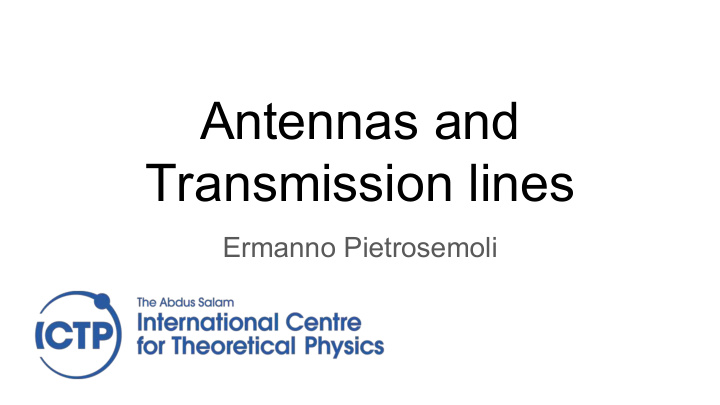



Antennas and Transmission lines Ermanno Pietrosemoli
Antenna and transmission line irrigation analogy Irrigation requires: A hose to transport the water to the sprinkler transmission line A sprinkler to direct the water to the specific area we want to irrigate antenna
Transmission Line A transmission line is the device used to guide radio frequency (RF) energy from one point to another (for example a coaxial cable, a bifilar line or a waveguide). Every transmission line will attenuate the signal.
Transmission Line The simplest transmission line is the bifilar line formed by two parallel conductors separated by air or an insulator. It will carry the RF signal from the source to the other end. There can be an alternating current even in an open ended transmission line, since the electrons will flow back and forth every half cycle
Transmission Line The electric field at a distant point created by the each of the currents will be of the same magnitude but in opposite direction and will therefore cancel.
Irrigation system components Hose Sprinkler Connector
Wireless system components
Any mismatch will cause a loss, which can be very high
G=Efficiency*Directivity
Omnidirectional antenna An omnidirectional antenna spreads the signal evenly in every direction of the plane
Directional Antenna A directional antenna forms a very narrow beam in a specific direction and very little energy is directed elsewhere. If the beam becomes much wider we will have a sectorial antenna
Sectorial Antenna Spreads the signal in certain angle of the plane, for instance 45 degrees, 60 degrees, etc. Often combined in a base station to provide 360 degree coverage, for instances 3 sectors of 120 degrees each.
Polarization is the direction of the Electric field
Collinear (omnidirectional) And Yagi (directive) antennas
Example of sectorial antenna usage Raila Christine
Thank you for your attention For more details about the topics presented in this lecture, please see the book Wireless Networking in the Developing World , available as free download in many languages at: http://wndw.net
Recommend
More recommend